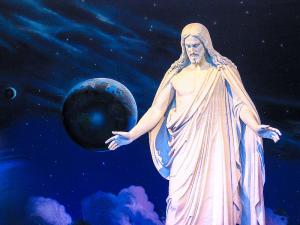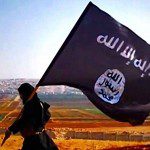In one month, General Conference will come again to the red brick building with the crossless gray spire that sits on Gloucester Road, the east-west artery into Hong Kong’s throbbing urban heart. By Hong Kong standards, the Wanchai building is a modest twelve-story low-rise, dwarfed on all sides by great and spacious towers easily over four times as tall. But small as it may seem, it contains worlds.
Hong Kong is famous for its diversity and discontinuities. Its tiny borders create a crowded space for the confluence of wealth, poverty, tradition, transience, centrality, marginality, urban, rural, East, West, and nearly everything else. In Hong Kong, Mormonism comes into focus as a dynamic global religion in which powerful forces of homogeneity and heterogeneity exert themselves side-by-side. This productive, load-bearing tension is especially apparent during the Church’s worldwide General Conference broadcasts in April and October.
When Conference comes to the Wanchai building, elevators are stuffed and staircases fill with Mormons tromping to and from rooms on the various floors of the building where the broadcast from Salt Lake City is being streamed in Cantonese, Mandarin, Tagalog, English, and Bahasa Indonesian. There are so many languages zooming back and forth over the building’s multimedia network that sometimes it goes haywire; in the middle of one Conference meeting last October, General Relief Society Presidency Counselor Linda S. Reeves suddenly began speaking Korean, necessitating a flurry of tech-shifting strategies and some impromptu congregational hymn-singing until she could be reacquired in English.
It would be possible to see the multiple floors of the Wanchai building as a symbol of the stratified nature of Hong Kong society or Mormonism’s centralized administrative hierarchy. And yet in the Wanchai building one can also see the kind of democratic leveling effects produced by Mormon community structure. For instance, after the October Conference’s General Relief Society meeting, the Vice-President of Operations at Hong Kong Disneyland and a professor at the University of Hong Kong (both white, U.S. expatriates) worked frantically to core, slice, and serve Granny Smiths to the intimidatingly long line of mostly Filipina maids snaking back and forth across the gym.
In Conference talks, the Church and its buildings are often spoken of as sites of refuge from an unfriendly world. The Wanchai building is a different sort of haven to different groups of Mormons. While most Indonesian and Filipina domestic workers in Hong Kong spend their day off in crowded parks and underpasses, sitting on plastic tarps, in the Wanchai building Mormon domestic workers have sofas and kitchens and clean bathrooms. While most early childhood music classes in Hong Kong are expensive and commercialized, Mormon expatriate mothers use the second floor Primary room every Thursday to run a cooperative “Musicmakers” class and to swap know-how about private school applications and places to get thick milkshakes.
The majority of Church members view the Sunday session of General Conference on a Sunday, but in Hong Kong this is not necessarily the case. Like deep-sea hydrothermal vents that sustain rare and unconventional forms of life, the extremely transient and fragmented nature of Hong Kong society has provoked rare and unconventional forms of Mormon congregations. Mormon domestic workers whose day off does not fall on Sunday attend the Sabbath services on Tuesday, Wednesday, Thursday, Friday, or Saturday. Two senior missionary couples from North America are assigned to superintend these full three-hour-block weekday meetings. They get Sundays off. Most Mormons are shocked to learn that these missionaries have official Church sanction to go to Disneyland on Sunday, but so it must be: Sunday is their Sabbath from the Sabbath.
Another way in which the Hong Kong domestic worker units are unusual is in their leadership structure. Leadership positions in nearly all Mormon congregations worldwide are dominated by men, including the executive secretary and ward or branch mission leader; the highest-ranking local female leader, the Relief Society president, is seen as an “auxiliary” leader with special stewardship over only the portion of the congregation that is female. In the overwhelmingly female domestic worker branches of Hong Kong, however, the Relief Society President exercises stewardship over nearly everyone in the congregation, and the executive secretaries and branch mission leaders are women. (When I asked a sister in the Island 1 Branch if the branch mission leader was really a woman, she gave me a blank look, as if I had asked whether President Monson, the Prophet, was really a man.)
When Conference comes to the Wanchai building, it is striking to see the forces of Mormon homogeneity and heterogeneity at work, side-by-side (or in this case, floor by floor). The same talk on the blessings of paying tithing is being broadcast in five different languages to people from over a dozen different countries whose incomes can range from 4000 USD a year to 4000 USD a month. When the Western expatriate branch and the Filipina branch watch Conference in English together in the big chapel on the first floor, the two groups often respond differently at different points in the talk, such as an audible gasp from one while the other is silent, or laughter from one while the other doesn’t quite understand what was funny.
Despite all of this difference and disjuncture, what is clear to the Mormons (including myself) for whom the Wanchai building is such a welcome place of spiritual, physical, and cultural refuge, is that Mormonism in Hong Kong works. By “works,” I don’t mean in the sense of “runs like a well-oiled machine,” but rather that it relies on the sustained effort of a lot of awkwardly shaped moving parts (i.e., people) to build the body of Christ, to supply miraculous answers to prayers in the form of service, and to fan the flame of faith against the suffocations of a dreary world.
This “Hong Kong Mormonism” where General Conference is viewed is no less authentic or representative than the “Salt Lake Mormonism” where General Conference is produced. If only, instead of panning around the audience seated in the Conference Center in Salt Lake City during congregational hymns, the camera could pan around the world, revealing not only individual Mormons of all colors and walks of life but also the many distinctive and unique expressions of Mormon community.
In the global Mormon community, the homogenizing and heterogenizing impulses within the faith are mutually supporting. The homogenizing impulse stems not just from the Church’s centralized administration, but most profoundly from our shared faith in the teachings of the restored gospel of Jesus Christ. The heterogenizing impulse stems from our view of Zion as not merely an idea or a belief, but a real community. Not only in Hong Kong, but from Los Angeles to Lubumbashi, these forces of sameness and difference come together in Mormon congregations — demanding ongoing negotiation and innovation, but also imparting strength and value to the community of faith because of the effort that they constantly require.
* To help promote international understandings of Mormonism, please consider donating your favorite Mormon studies book (or two, or four) to the International Mormon Studies Book Project!











